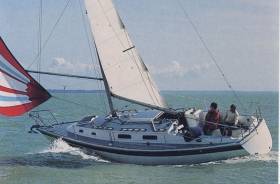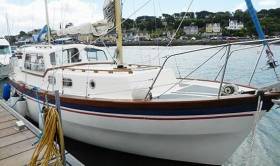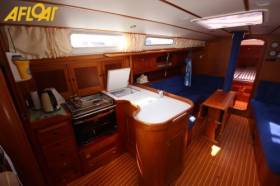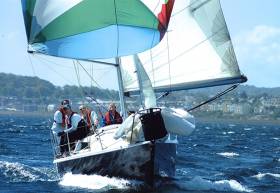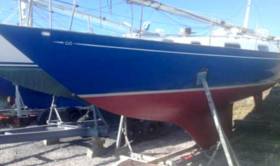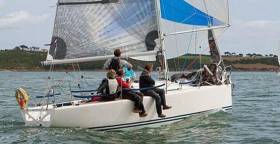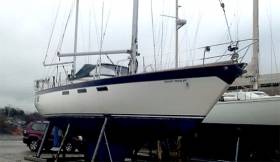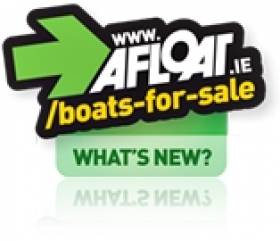Displaying items by tag: boats for sale
Westerly Fulmar is All Rounder With Used Boat Sales On Post–Brexit Surge
“I’m busier now than I was in June or July” is the cheerful response from John McDonald down in Kinsale at the south coast MGM Boats boats for sale office writes W M Nixon. Normally there’s a slowing down of sales as Autumn draws in, or brokers might find their time being taken up by the perennial tyre-kickers who will only move if an absolute bargain is in the offing. But September 2016 has been different.
The affable and informative McDonald reckons it’s the post-Brexit effect. Much and all as Brexit on June 23rd was only an electoral decision, and nothing concrete has as yet flowed from it – indeed, it could take years for any significant changes to kick in – the feeling is that when a major decision is coming down the line, every other decision is deferred. So the fact that a decision has been made, whatever about its longterm consequences, is better than a state of uncertainty.
For Irish boat buyers and sellers, the main interest lay in the effect on the euro-sterling rate of exchange, and we’ve reported on Afloat.ie about the way Howth YC maximised on the initial plunge in sterling by sending off a very focused procurement team to the Solent area in search of four good J/80s for use in the club’s sailing development programme. They hit the ground running to find the exchange rate in such such a sweet place that they came back with five J/80s.
But now things have stabilised, rates of exchange seem to have settled down with sterling at a lower level, and boat buyers can move with a clear idea of the true comparable prices between boats in the Euro zone and across the water.
This Westerly Fulmar 32 is back on the market with MGM Boats through a change in the owner’s circumstances. The significance is that an already good example of the noted collaboration between leading designer Ed Dubois and volume boatbuilders Westerly Marine is available at a price of €33,950 which seems even more attractive when you factor in the impressive array of new equipment and sails she has acquired during the past year.
The Westerly Fulmar 32 is the very epitome of a “sensible” boat. She’s a big 32–footer, yet the designer didn’t try to shoehorn in more accommodation than there was comfortably room for, and the result is she actually seems even bigger than she really is.
But this doesn’t come with an impairment of performance. On the contrary, the Fulmar achieves the ideal of a more-than-respectable average speed when sailing on a cruising passage, and it’s all done in a sea-kindly boat in which the miles slip effortlessly by. In this case, the high standard of equipment is matched by a very good general level of maintenance, providing the ideal package in a very attractive size range, details here.
Motor Sailer Which Is Just The Job For The Irish Climate
In her day – which began in 1973 – the John A Bennett-designed Colvic 31 received deserved admiration as the kind of motor-sailer, complete with a proper deckhouse, which any sailing enthusiast thinking about moving into more comfortable boat territory could seriously contemplate writes W M Nixon. The boat is advertised here among the popular listings on Afloat Boats for Sale.
And at their lovely old world boatyard of Kilmacsimon, set among the trees on the west side of the estuary between Kinsale and Inishannnon, George Kingston and his team created a particularly good version, the Simon 31, based on the Colvic hull and deckhouse, but with lots of clever Kingston touches added.
The result was an able yet unostentatious boat which suited the average Irish summer very well. The fact that we’re in a summer which is even more average than usual will make this 1980 version of interest for people who wish to continue cruising, preferably with a bit of sailing thrown in, but are fed up with having to haul on and haul off the foul weather gear several times a day.
For sure if the weather’s fine, you can helm this ketch from the cockpit. But there’s an equally well-serviced helmsman’s station at the forward end of the roomy deckhouse, and if the weather turns foul you can trundle comfortably along under that most accommodating of rigs, the engine at gentle revs with headsail and mizzen pulling well and the main neatly stowed.
With her full draft of 4ft, she certainly has sailing capability. As for her general roominess, it’s astonishing – this is one very big 31 footer. And her looks are handsome, speaking eloquently of practicality.
The price of €19,950 is realistic, for as some of the photos show, she’s beginning to show her age in a few areas, and experienced advice would probably have it that an engine replacement might be in order. But a fairly heavy classic diesel like the Thorneycroft BMC can go on for a very long time, for if I remember rightly, this is the marinised version of the engine developed for London taxis, so not only is it bullet-proof, but replacement parts are very competitively priced.
As to sea-going capability, the Colvic 31 motor-sailer was the boat used by cruising author Wallace Clark for the ventures of his latter years, in one of which he was awarded the Irish Cruising Club’s Rockabill Trophy for Seamanship. This was in recognition of his skill in bringing his Colvic 31 through the appalling tide-rip which can develop off the Mull of Oa, the southwest corner of Islay in the Hebrides. As he cheerfully admitted, it was his own mis-timing of tides which resulted in his being somewhere he shouldn’t have been next nor near in the first place. But the way in which his little boat came through, battered and bedraggled but triumphant, was a credit to John Bennett’s very sensible design.
Afloat Boats For Sale Guides Us To Arcona Beauty
Every so often a boat comes up on the Afloat.ie Boats for Sale listings which has the magic Ingredient X in abundance writes W M Nixon. And this Arcona 370 - on the site from MGM Boats’ Kinsale office - is spot on the target. Everything about her – including her stylish dark blue hull and flawless teak deck - talks of class. And broker John McDonald’s photos, taken on board just a week ago, clearly tell us that “immaculately maintained” is scarcely adequate to describe her enviable condition.
You wouldn’t think she’s eleven years old, but she dates from 2005 when the Arcona 370 joined the rather exclusive range of four performance cruisers for connoisseurs by Arcona Yachts in Sweden. Since then, the 430, 410 and 380 have increased the selection further. But if you wanted to select a mid-size design which exemplifies the dynamic interaction between Arcona and their designer Stefan Qviberg, the Arcona 370 does it in style.
Arconas are boats which seem to suit enthusiastic cruising couples particularly well, and former International Fireball Champions Adrian & Maeve Bell from Strangford Lough have been so taken with the marque that they’ve owned two of them and made award-winning cruises with both, their current one being a 430.
This Arcona 370 has been used for the same sort of competent cruising, with the owner and his wife (they have had the boat from new) regularly taking in the Breton and French coasts down as far as La Rochelle in their many annual ventures. Although Kinsale-based, being British owned she’s British priced, at £109,950 GBP, and as she’s one of the most fully-equipped yachts currently on the Irish market, her-ready-to-go condition makes her a very attractive proposition.
Click for the Arcona advert here.
If ever you call by Baltimore in a cruising boat at the height of the summer, you’ll find you’re rubbing shoulders with sailing families from all over Ireland writes W M Nixon. This is despite the popular view that the thriving Baltimore Sailing Club is a sort of Royal Cork Yacht Club West. For sure, there are plenty of Crosshaven folk with a second base in West Cork. But the appeal of Baltimore is such that in the best of the sailing season, the thronged waterfront is filled with summer-resident amateur sailors at every level of dedication from all corners of Ireland.
Typical of them is the extended Kennedy family from Belfast. Originally, the Kennedy brothers Hugh, Joe and Frank learned their sailing at Whitehead at the northeast corner of Belfast Lough, as their mother had family connections to the peninsula of Islandmagee to the east of Larne Lough, and Whitehead is the gateway to Islandmagee.
My own family got to know the Kennedys when the three brothers bought the Belfast Lough 18ft Waverley Class Rowena from my father in 1948, when he in turn was moving into partnership with my uncle in one of the then-new Belfast Lough Glen Class 25-footers.
Although the Waverleys had originated in Whitehead where they were created by the amateur designer John Wylie in 1902, a strong branch of the class had soon developed across Belfast Lough in Ballyholme Bay, and it was from here that our family’s Rowena – Waverley No 1 - was sold to the three brothers who went on to enhance her already-established reputation as one of the fastest boats in the class.
In time the Kennedy sailing reputation spread into other boat types, with Hugh – who became a successful barrister – spreading his wings in a big way in dinghies, while Joe – who had become a surgeon - was more into keelboats. Our families were linked in sailing, as Joe crewed for one of my brothers on a cruise to the Faroes in a 37-footer, while another brother crewed for Hugh in dinghies right up to the top level in 505s.
It seems to have been the dinghy racing which began the Kennedy link to Baltimore. Successful Dinghy Weeks at the West Cork venue in 1960 and 1964 created friendships in a growing matrix which eventually blossomed into marriage into the Cork sailing community. So though the Kennedys were very much Belfast-based for ten months of the year, for at least six weeks of each summer they were paying a central role in the Baltimore sailing
scene.
That Baltimore scene had become very active by the late 1970s, and when the David Thomas-designed Impala 28 was unveiled in 1977 as the smallest of a trio of officially-sanctioned Offshore One Designs, the brains of Baltimore got to thinking that this would be an ideal boat for their summer sailing needs at the heart of one of Europe’s best sailing and cruising areas.
One of those to whom this appealed was Joe Kennedy, and when his new Impala 28 appeared in 1980, naturally she was called Rowena. In Baltimore she became part of a local phenomenon, as the summer Impala fleet there – though based on a solid nucleus of only four boats of which Rowena was one – could swell rapidly to fleets of 15 and more when they staged popular events which became known as the Impala 28 Europeans.
For some years now, Rowena has been in the ownership of Andrew Kennedy, a surgeon like his late father Joe. But after this rare example of a boat being with one family for more than a quarter century, family pressures mean he simply has to upsize, and Rowena had just been freshly-commissioned at Bangor Marina, and is for sale at the very reasonable price of €5,700.
Admittedly you are getting a very basic Impala 28 just as David Thomas envisaged her, albeit a boat in good order. David Thomas was obsessed with saving weight, thus though the Impala 28 is quite voluminous with plenty of room for an inboard auxiliary, he insisted that she be fitted only with an outboard, and in line with this, Rowena comes with a very modest Yamaha 6hp four-stroke.
However, many early owners became exasperated by the hassle of an outboard and loathed the unsightly way it hangs off the transom, so they soon started installing the new small inboard diesels which were coming onto the market at the time. The result was not only neat and reliable, but despite having to trail a feathering propeller, it was found that the extra weight low down in an optimal position within that roomy hull might actually have improved windward performance in a breeze.
It’s something to think about if you’re looking at Rowena. But happily it’s not a priority – she’s ready to go. She comes complete with a two-burner gimballed stove in the galley, she has been recently re-wired, and her equipment includes ICOM CHF, new NASA Depth and Speed, and a Mark 2 rudder for those who might be interested in the Impala’s still very viable racing possibilities.
As to the original Rowena, eventually she moved back into Ballyholme ownership, and this being in the days before Bangor Marina had been created, in one of those rare but vicious northeasterly gales which sweep the anchorage in Ballyholme Bay from time to time, the first and fairest of the Waverleys was sadly lost. However, it’s rumoured that her ballast keel is still around, in a hidden corner of Ballyholme YC boatpark. Now there’s a real opportunity for someone who likes re-creating classic yachts…….

Waverley Class No 1 Rowena (at right) in Carrickfergus Harbour during a Carrickfergus SC regatta around 1950, when she was owned by the Kennedy brothers of Whitehead. The Carrick club – which this year is celebrating its 150th anniversary – was housed in those days in the white boathouse at mid-photo.
The full advert giving a very complete inventory is on the Afloat boats for sale site here
Some boats are just boats, but the Contessa 32 is a statement writes W M Nixon. If you have a Contessa 32, you’re telling yourself - and everyone else too, if it comes to that - that some day you might just be minded to sail off towards the far horizon “and other places beyond the seas”.
That’s how the resonant phrasing of old maritime law used to have to it, and it certainly evokes images of boundless possibilities which today’s dry legalese doesn’t quite capture. “Other places beyond the seas…..” With the PC overheating in front of me and the grass outside needing mowing yet again, who wouldn’t think of sailing away to other places beyond the seas? And with a well-found Contessa 32, you can confidently contemplate doing so.
This example of a 1974 Contessa 32 is down Galway Bay way, and owner Pat MacSweeney is selling her privately. While the basic boat is 1974, the good news is that the engine was replaced in 2007 with an 18hp Yanmar 2GM20F with just 120 hours on it, while in recent years at least, the boat has been only lightly used.
At a boat show among contemporary 32-footers, you’d hardly notice the Contessa 32 – she’s only a slip of a thing. While the saloon/galley area is very comfortable, it’s not enormous, and the forecabin is decidedly limited in space. Thus the recommendation is that the Contessa 32 is at her cruising best with not more than three adults on board. But as the more crusty of us can just about get along with just one other adult, that’s no great problem.
So what, apart from her restrained good looks and lack of vulgar bulbousness, is the Contessa 32’s USP? Oddly enough, it is that very lack of a high-volume hull which is what attracts the serious ocean-going sailor. No boat type emerged better from the analysis of the 1979 Fastnet Race disaster than the Contessa 32. For although with their slim hills and relatively low freeboard they may have had the seas sweeping over them, unlike high volume craft they weren’t chucked about like balloons on the bouncing sea. They not only came through with credit, but one of them - Assent sailed by Alan Ker - was winner of Class IV.
That same Assent was subsequently cruised by her owner, Alan’s father the legendary Willy Ker, to some very other places beyond the seas. Thousands and thousands of miles he sailed. But two or three years back, the great Willy Ker finally swallowed the anchor, so the Rogers family of Lymington, who built the entire Contessa range, took the boat in for a complete restoration, and she’s now as good as new.
But a new Contessa 32 costs the earth, as this is quality stuff. Thus a 1974 Contessa 32 in reasonable order at €19,250 is well worth a look. I fact, I can think of someone who recently had a serious maritime setback down in the Galway Bay area who should be having a look at this boat, for it’s time to get back in the saddle. Check out the full advert on Afloat boats for sale
Two Corby 25 IRC Racers For Sale on Afloat.ie
Have you ideas about purchasing the perfect IRC racer with occasional day cruising possibilities? Are you looking at a yacht with an overall length of 25 to 28–ft, to suit a crew of four or five? Are you working off a budget of somewhere between €30–40,000? Maybe you also want the possibility of sleeping on board for a lads weekend with fish and chips for supper? A focus point for your consideration then has to be the Corby 25 which offers so much more potential than a sportsboat. Afloat.ie boats for sale currently has two of these highly successful IRC designs listed for sale.
The Corby 25 is a fast sailing racing boat, it is built and designed to sail with great upwind performance. Corby 25s are typically of GRP hull construction, fitted with a fin keel and bulb and a spade rudder. Due to her relative high weight (2t) 50 % in the keel, the Corby 25 is very stiff, holding all sails up to 20–knots true wind, she reaches an apparent upwind angle of about 17 degrees and therefore has an ability to sail higher than most of her competitors.
These fractional sloops are also fitted with small saildrive inboard diesel engines.
Inside the Corby 25, there are typically four berths: two are under the cockpit and two in the central cabin. One toilet is installed in the front cabin. A flexible water tank is fixed to supply an outside shower with an electric pump. A maritime kitchen (one burner) on gimbals is available in option with an outside gas storage (EU norms).
The first of these listed on Afloat boats for sale is a 2004 version afloat in Cork. At €39,500 she is a previous winner of the ICRA 'Irish Boat of the Year' so has proven speed, according to Boatshed Ireland's Ken Lawless. Full advert here.
The second is a 2000 version an according to seller Liam Burke she is 'not your standard GRP production boat' but custom built by John Corby in the UK from Cedar strip and Epoxy making her lighter and stiffer than the subsequent production models'. At €29,500 this 2000 built boat had a hull respray in 2015. Full advert here.
Discounted Inflatable Tender at €450 From O'Sullivan's Marine
O'Sullivan's Marine in Tralee County Kerry has a range of discounted inflatable tenders for sale. The WavEco 2.30M solid transom has an air floor and has a special offer price of €450 down from €525.
The WEC230 AM/3 has a max horsepower of 3hp and a capacity for 3 persons. The packing size is 105cm x 60cm x 32cm and weighs only 31kg. The quality fabric is made from 750gram 1100 Denier polyester and is covered by a three year limited warranty.
See the full line up of boats for sale here.
This well known Oyster 39 ketch, (ex Morningtown) acted as the RORC escort and radio relay boat during the infamous 1979 Fastnet Race. She was responsible for relaying the positions of the racing fleet.
Her inventory includes a Ford 80HP diesel engine, wheel steering, nine berths, bow thruster, 3 blade varifold propeller, furling genoa, slab reefing mainsail, lazybag, colour chartplotter, radar, AIS, autopilot, life-raft, sprayhood and more.
She is a solid blue water cruiser and has been well looked after, according to Broker Hugh Mockler of Crosshaven Boatyard. More details here.
Top Quarter Tonner 'Supernova' For Sale at €14,995
The 1978 Ed Dubois designed and professionally IRC optimised Quarter Tonner Supernova is for sale for just under €15,000. The 2011 winner of Volvo Dun Laoghaire Regatta is advertised on Afloat boats for sale here.
#afloatboatsforsale – As the Euro continues its dip, UK boat buyers can eye the Irish boat market as if it's staging a giant 15 percent off sale!
There's bargains for our neighbours and Afloat's bustling boats for sale with 400 boats for sale shows the very latest in this value, right at the start of the 2015 boating season!
With the European economy slogging along at a near standstill, the euro has slid to a nine year low offering boat bargains to UK consumers and anyone else paying in sterling.
The outlook for the euro against the pound sterling has improved slightly but at GBP/EUR 1.3888 it's hard to see when this might change.
In the meantime, potential UK buyers might want be tempted by these latest boat bargains. For example a Cork harbour based motor–sailer with a ketch rig at €56,000 has just come on the popular sailing cruisers section of Afloat boats for sale. The Rogger 36 is one of the last boats out of Stargate Marine and has been in present ownership since 1988. A 1991 Cornish Shrimper, a lifting keel gaff rigged sail boat, based in Waterford has also just been added at €14,000. A Dundalk based 1989 Dufour 39, a modern classic from the drawing board of German Frers, is on the market for €47,500. Click for 400 more boats for sale in Ireland.


























